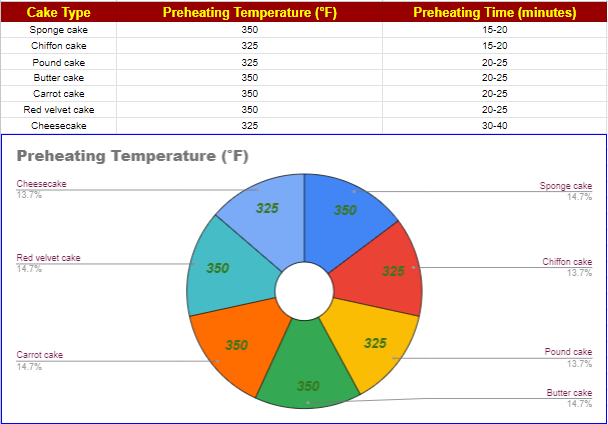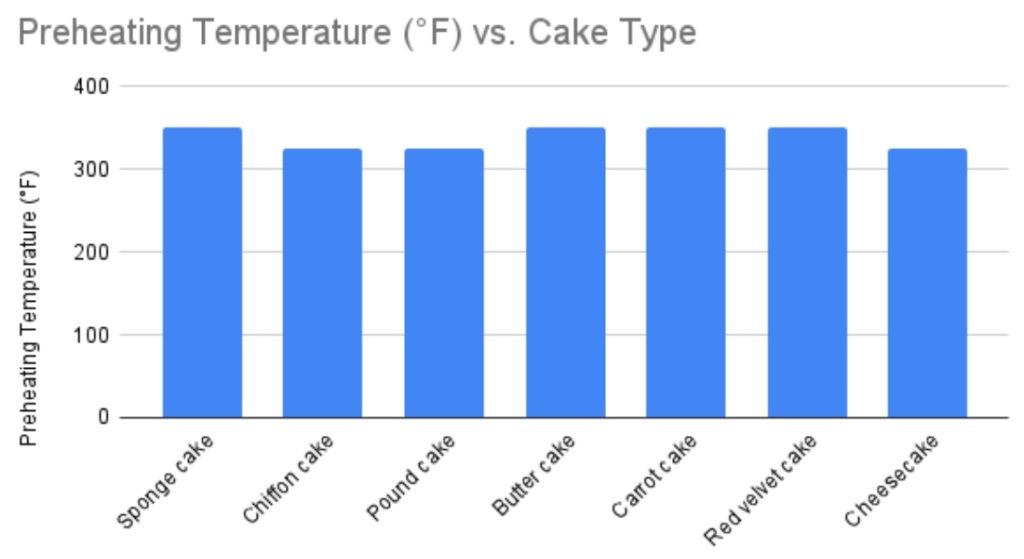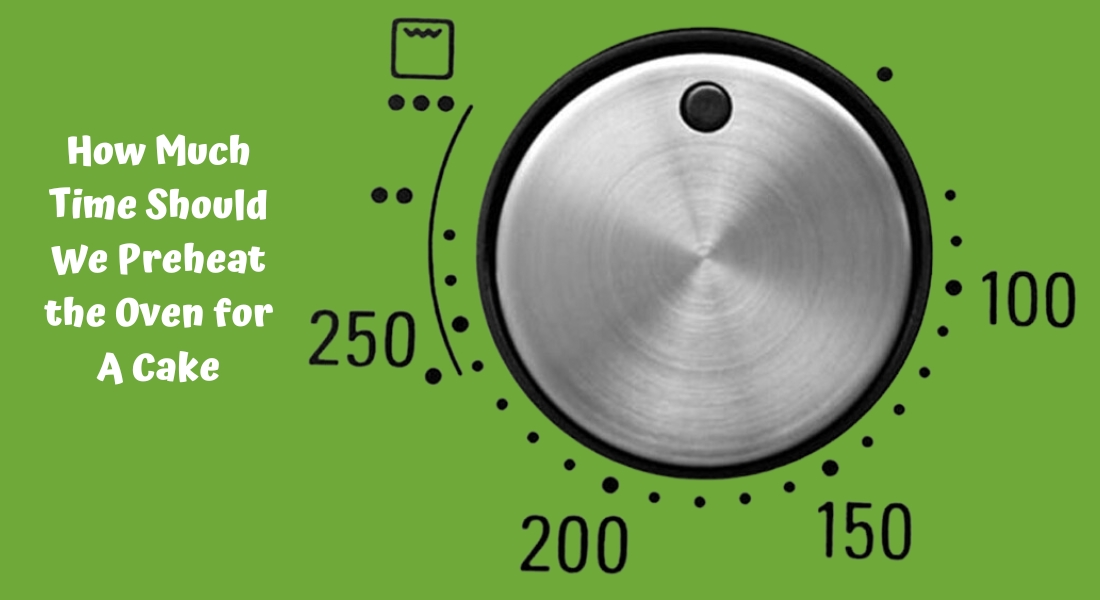Most food scientists said that the length of time to preheat the oven for a cake your oven dependent on the characteristics of cake you are baking and how hot your oven is. Normally, It takes most ovens about 15 minutes to warm up – up to 350 degrees Fahrenheit (175 degrees Celsius).
You will need to heat the oven for a longer time if you are baking a cake at a higher temperature. Let’s say you want to bake a cake at 200 degrees Celsius (400 degrees Fahrenheit). The convection oven will need to be heated up for about 20 minutes.
Garrison, et al. (1986) titled “Effects of Radiant Heat Transfer: Cake Baking in a Conventional Electric Residential Oven” examined that it was thought that a cake-pan radiometer was used to measure the amount of irradiation. More radiation on the lower cake surface made the cake lose more humidity and form a bottom thick layer faster during baking.
This happened because more radiation hit the top of the cake, making that surface brown faster. Less surface yellowing was linked to both losing more moisture and having a relatively small dessert amount.
Follow our research teams guides and stay tuned to last to learn more about how to heat the oven to different temperatures for cakes and other factors that relate.
So, let’s dive in here!
Initially, we are researching the How Many Temperatures to Prepare Oven for Cake
Preheat Oven for Cake – A Research Review
Stinson, C. T. (1986) titled “Effects of microwave/convection baking and pan characteristics on cake quality” recommended that the largest influences were the multi – layer perceptron baked at a particular time and the features of the baking pan. The starting convection oven temperatures also were of secondary importance. These things had an effect on the color of the the following things.
- Crust,
- The cake’s moistness, and
- Its symmetrical.
One example is that single layers got a lower sensory score and had less red and moist crusts than double layers. A cake baked in a glass-polyester microware pan had a peak, but an aluminum pan cake was flat. Both subjective and objective tests showed small differences in quality, but all of the cakes were good enough.
Here is a table and a pie chart that show how long it takes for different oven temperatures to heat up:

Keep in mind that these are only suggestions. The exact amount of time your oven needs to heat up may depend on the brand and model. Always check the manual that came with your oven for exact instructions.
So that the cake cooks evenly, it’s important to temp the oven for the right amount of time. What if you don’t heat the oven long enough? The cake might not be cooked all the way through. The cake might get dry if you heat the oven for too long.
It is possible to use an oven thermometer to see if your convection oven is already heated to the right level. Just put the thermometer in the oven and wait for the temperature you want to reach.
Making sure the oven is hot before putting the cake in it is very important so that the cooking can start right away. The cake may start to rise and fall if you leave it out at room temperature for too long. This can make the cake crack or be uneven.
Then, we are reviewing the 4 Easy Guidelines for Setting up Your Oven for A Cake
4 Simple Tips for Preheating Your Oven for A Cake
Here are some more tips on how to get your convection oven ready for a cake:
- The racks should be in the middle of the oven. It will help the cake cook all the way through.
- To find out how hot your oven is, use an oven thermometer. This will help you get the oven ready by making sure it is at the right temperature.
- While the cake is baking, don’t open the oven door. The cake might fall because of this.
- Before frosting the cake, let it cool all the way down. The frosting won’t melt as easily this way.
Following that, we are examining the Preheat Oven To 180 or 200/220 Degrees – A Straightforward Review
Preheat Oven To 180 or 200/220 Degrees – A simple Review
Tan, Zhang, & Gao, (1997) stated that the main things that affect the quality of bread during the baking process are the following factors.
- Water,
- Enzyme activity,
- Starch,
- Protein properties, and
- Heat.
The shape and strength of the bread depend a lot on its cellular structure, which affects how it feels. You may also gather knowledge on chicken breast mastering process.
Sanchez-Pardo et al. (2012) said that surface response analysis was used to find the best baking conditions for the two-cycle microwave-toaster oven. As for what worked best for baking, 204 W of power for 120 seconds during the first cycle, 937 W of power for 70 seconds during the second cycle, and 5 minutes of toasting at 200 °C were the best settings.

Of course, it takes between 8 and 10 minutes for an oven to heat up to 180 degrees Celsius (356 degrees Fahrenheit). It usually takes between 10 and 15 minutes for an oven to heat up to 220 degrees Celsius (428 degrees Fahrenheit). Sometimes extra overheating make the cake spoil, consequently after eating may cause cancer.
The accurate preheat time can change, though, depending on the type, size, and efficiency of the oven. It might take a little longer for older ovens to heat up than for newer ones. Also, it might take a few more minutes for bigger ovens to reach the right temperature than for smaller ones.
To make sure the preheating is done right, you should use an oven thermometer to check the temperature inside. This will give you a more accurate reading of when the oven has reached the right temperature, since oven indicators aren’t always right.
Here’s a general guideline for preheat times:
- Eight to ten minutes for most baking jobs
- 10-15 minutes for bigger ovens or older ones
- Twenty to thirty minutes for baking stones or Dutch ovens
Recollect that it’s better to preheat for a little longer than to risk baked goods that aren’t done or are cooked unevenly. After setting the oven to the right temperature, put the food in it right away and start baking so that the heat doesn’t escape.
After Preheating Oven-Do You Turn It Off
No, you don’t turn off the oven once it’s hot. For the food to cook right, the oven has to stay on at the right temperature. The oven will cool down after you turn it off, and your food will not cook all the way through or evenly.
4 Best Tips for Using Your Oven
Here are some tips for using your oven:
- Always get your oven ready to go by following the recipe’s instructions. This will make sure that all of your food cooks evenly.
- Opening the oven door while food is cooking is not a good idea. This might make the temperature drop and the food cook in different ways.
- Check the temperature of your food inside with an oven thermometer (mentioned before).
- The best way to tell when your food is done is to do this. Let the food cool down a bit before you touch it. It will help you stay safe from fire.
Final Suggestions
Our research team has made final suggestions for getting your oven ready to use.
Read the Recipe: For instructions on how to heat the oven, you should always check the cake recipe you’re using. Based on the type of cake you’re making; the recipe may tell you what temperature to use.
Preheat to the Recommended Temperature: If the recipe calls for 350 degrees Fahrenheit (180 degrees Celsius), heat your oven to that level. Ten to fifteen minutes is usually enough time to get to this temperature, but use an oven thermometer to be sure.
Prepare the Pan or Baking Dish: Whereas the oven heats up, grease or line your cake pan or baking dish according the directions in the dish.
Avoid Opening the Oven Frequently: Once the oven is at the right temperature, don’t open the door several times before putting the cake in. This helps keep the temperature steady so that the baking goes smoothly.
Position the Rack Correctly: Make sure the oven rack is in the middle or where the recipe says to put it. Putting the cake on the right level on the rack makes sure that the heat spreads out evenly.
Monitor Baking Time: Once a cake is in the oven, bake it for as long as the recipe says to. Utilize a cake tester or toothpick to keep track of time. to check if the cake is done. When the cake is done, the tester should come out clean.
Avoid Overbaking: Be careful not to bake the cake too long, as that can make it dry. Watch how the cake is baking in the last few minutes and take it out of the oven right away when it’s done.
By implementing these strategies, you can make sure that your oven is properly warmed up and ready to bake a tasty cake. This will help your research team’s project go well and taste great.
References and Link Sources
- https://onlinelibrary.wiley.com/doi/abs/10.1177/1077727X8601400307
- https://ift.onlinelibrary.wiley.com/doi/abs/10.1111/j.1365-2621.1986.tb13871.x
- Stinson, C. T. (1986). Effects of microwave/convection baking and pan characteristics on cake quality. Journal of Food Science, 51(6), 1580-1582.
- Tan et al., 1997 J. Tan, H. Zhang, X. Gao, “Comparison of pound cake baked in a two-cycle microwave-toaster oven and in conventional oven” SEM Image processing, analysis and machine vision, Brooks Cole Publishing, CA (1997)
- Sanchez-Pardo, M. E., Ortiz-Moreno, A., García-Zaragoza, F. J., Necoechea-Mondragón, H., & Chanona-Perez, J. J. (2012). Comparison of pound cake baked in a two-cycle microwave-toaster oven and in conventional oven. LWT-Food Science and Technology, 46(1), 356-362.
- Garrison, C. L., & Peart, M. V. (1986). Effects of Radiant Heat Transfer: Cake Baking in a Conventional Electric Residential Oven. Home Economics Research Journal, 14(3), 336-341. https://doi.org/10.1177/1077727X8601400307
As a 10 years veteran in the culinary industry, I have developed a passion for all things kitchen. With a deep understanding of food preparation and cooking techniques, I am a true kitchen specialist. My experience working in Khedmot kitchen has allowed me to hone my skills and become an expert in creating delicious and visually appealing dishes.
I am a creative and innovative chef, constantly experimenting with new ingredients and cooking methods to bring unique and memorable dining experiences to my customers. In addition to my culinary expertise, I am also highly organized and able to effectively manage a team of kitchen staff, ensuring that all tasks are completed efficiently and to a high standard.
I am dedicated to my craft and always strive to create exceptional dining experiences for my customers. Whether it’s developing a new menu, training my kitchen team, or working with local suppliers, I am always looking for ways to improve and take my kitchen to the next level.
If you’re looking for a skilled and passionate kitchen specialist, look no further. I am eager to bring my expertise to your team and help take your kitchen to the next level.


